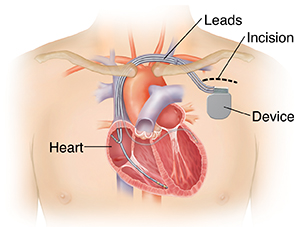Understanding Cardiac Resynchronization Therapy (CRT)
Understanding Cardiac Resynchronization Therapy (CRT)

When you have heart failure, fluid can build up in your lungs and your legs (edema). You may have less energy and be short of breath. These symptoms interfere with daily life.
CRT uses a small device to help improve the timing of the heart’s contractions. CRT can ease symptoms, improve your quality of life, and help you live longer.
How CRT Works
With CRT, a small electrical device (pacemaker or defibrillator) is put under the skin in the upper chest. This is a minor surgical procedure done at a hospital. It is not heart surgery. Wires from the device lead to the ventricles. The device sends electrical pulses to each ventricle at the same time. This keeps the ventricles beating in sync . This procedure is also called biventricular pacing or resynchronization pacing.
CRT can be done with 1 of 2 devices. The type of device used depends on the person’s needs. The devices are:
A biventricular pacemaker. This device helps the heart beat at a normal rate.
A biventricular ICD (implantable cardioverter defibrillator). This device is a pacemaker but also can treat fast, life-threatening heart rhythms.
Reasons for CRT
Your healthcare provider may advise CRT if:
You have heart failure symptoms and your heart doesn’t pump well
The ventricles are not working together
Tests, like an echocardiogram, show that your heart is weak and enlarged
Medicine and lifestyle changes are not working well enough to control your heart failure
Benefits of CRT
CRT won’t replace your other treatments. It’s part of a complete heart failure treatment plan. CRT helps a weakened heart do a better job of pumping blood out of the heart with each beat. So, more blood and oxygen go to the rest of your body. This can decrease heart failure symptoms and improve survival. The device is put into your body during a low-risk procedure.
Not everyone with heart failure benefits from CRT. CRT improves symptoms in about 2 out of 3 people who get it. For those who have mild symptoms, it can also prevent worsening heart failure. With CRT, you may be more able to:
Return to daily activities such as walking, carrying grocery bags, and climbing stairs
Have more energy to be active and do the things you enjoy
Breathe more easily when you lie flat, so you sleep better at night
Have less swelling in your ankles, feet, and abdomen
Make fewer visits to the hospital because of heart failure symptoms
Have fewer side effects from your heart failure medicines
Risks and complications
Like all medical procedures, having a CRT device implanted has some risks. These include:
Anesthesia reactions
Swelling or bruising in the upper chest area where the CRT device is placed
Bleeding
Infection
Heart rhythm problems
Collapsed lung
Nerve or blood vessel damage
Movement of the device or the device wires, which may require a second procedure
Mechanical problems with the CRT device
Kidney damage
Sudden worsening of heart failure
Other risks related to your specific medical condition
Life with CRT
If you have a CRT device, you may need to stay away from certain electronic devices and devices that have strong magnetic fields. These devices can interfere with how the CRT device works. You will need to avoid anti-theft systems, security metal detectors, CB radios, and very strong magnets, such as those used in MRI. However, depending on the type of device you have implanted, you may be able to undergo an MRI with certain precautions in place. Talk to your cardiologist and the radiologist to make sure it is safe.
Your provider may also give you specific instructions for using cell phones and headphones with mp3 players. Your provider may give you a list of other devices and procedures to avoid. Most people with CRT devices can still enjoy physical activity, including sports and exercise.
You should not drive until your doctor says it's OK. The driving restriction is done to be sure that your health condition does not cause a safety issue for yourself or others on the road. Ask your provider when it may be safe for you to continue to drive.
You will have regular appointments to see how the device is working and to check the battery life of your device. Some of the device monitoring can be done using a home device that transmits the information about your device to your provider's office over a telephone or internet connection. The battery, or generator, will have to be changed at some point and your provider will let you know as that time approaches.
Updated:
March 21, 2017
Sources:
Cardiac resynchronization therapy in heart failure: Implantation and other considerations, Up To Date, Nordbeck, P., Magnetic resonance imaging safety in pacemaker an dimplantable cardioverter defibrillator patients: How far have we come? , European Heart Journal (2015); 36(24); 1505-1511, Sinjin, L. Clinically significant magnetic interference of implanted cardiac devices by portable headphones. Heart Rhythm (2009);6; 1505-1511
Reviewed By:
Image reviewed by StayWell medical illustration team.,Kang, Steven, MD,Snyder, Mandy, APRN